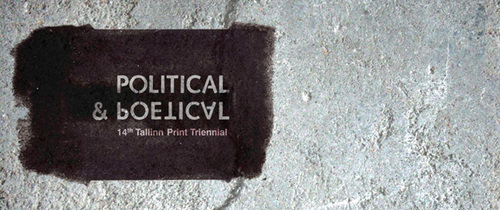Political / Poetical
dal 16/10/2007 al 26/11/2007
Segnalato da
16/10/2007
Political / Poetical
Kumu Art Museum, Tallinn
The main exhibition of the 14th Tallinn Print Treiennial "Political / Poetical" consists of the international competition (participating artists will be selected by an international jury) and Baltic part. What kind of "semantic displacements" are called forth by pouring a political text into a poetic mould. When does the poetic become political and vice versa?

14th Tallinn Print Triennial
Short introduction
There can be no doubt about the historical role of printmaking as a political medium. From the moment it was born it became political because in the post-Gutenberg world of the reformation it was the reproduceable quality of printing that provided the lower classes with the opportunity to represent themselves and their values. It was printing that made it possible for the rapid and effective spread of information among the illiterate peasants, and which at that time mainly took the form of small sheets with caricatures ridiculing the nobility and the church as well as images depicting the sorry situation of the peasants. The ability to print multiple copies, and that it was relative cheap and easy to distribute was what made printed material a powerful political weapon. Political prints of the reformation period certainly represent an area where artistic quality gave way for the more important social political message.
Printing maintained its important political function until the arrival of photography, but even then areas associated with the printed image have remained tied to politics. Think for a moment back to the comics amd political graffiti hijacked by the situationists, the culture of political fliers, the adbusters movement, etc. which all to a greater or lesser extent are grounded in the tradition of political prints. One should not forget to mention, for example, drawing, which many radical artists continue to consider the most democratic art form – it is easy and cheap to make. You can draw anywhere, it is always possible to find a bit of free wall or a piece of paper and a stick of charcoal or a pencil and you have all you need to make art. Add to this that it was only a while ago that certain caricatures or to be more precise printed artworks took us to the brink of war between civilisations, and not, for example, the torture of prisoners in Cuba or the hundred thousand children who died in the first bomb attack on Bagdad.
So an element of print culture continues to take part in political processes and plays a fairly important role. Certainly, it is this aspect of the print, unlike the technically accomplished art printmaking decorating our grandmothers' walls, which is interesting and even intriguing from the point of view of contemporary art.
Another quality, which has apparently historically always accompanied prints, is a certain poetry and not so much in terms of artistic expression, but even the qualities of the medium itself. Being right from the start, a secondary medium, the canons and strict rules of "great art" were slightly less applicable and this permitted artists to express themselves more freely and idiosyncratically.
"Poetic language" as understood by Russian formalists is different to ordinary language but not because it contains departures from the norm, but because it is almost an otherness of language, a special situation in language as was expressed by Mihhail Lotman in his lectures. The language of poetics as the language of transparency (where the word is forgotten in the interests of the indicated object or concept) is a language where "the aim of the writer is to work more with the sounds and rhythms rather than the meaning, and so highlighting semantic displacements", as Viktor Sklovski suggests. So therefore the language of Shakespeare and the Marquis de Sade, as well as the language of the mentally disturbed and the many languages in between can be poetic.
Within the context of the given exhibition we are interested in such (graphic) expression which unites both the political and the poetic. What kind of "semantic displacements" are called forth by pouring a political text into a poetic mould. When does the poetic become political and vice versa? Is Xerox-copy based political propaganda just romantic self-deception, a microscopic resistence, serious political action, poetic self expression or all of the above? These and many other questions form the tangle of issues in this exhibition. Anders Härm
Opening 17 October 2007
Kumu Art Museum, Great Hall
Weizenbergi 34 / Valge 1 Tallin



